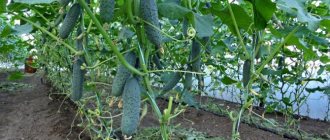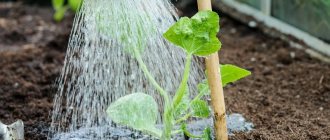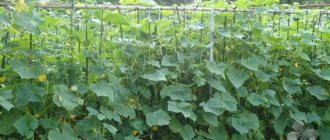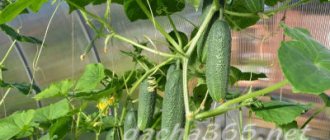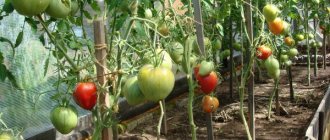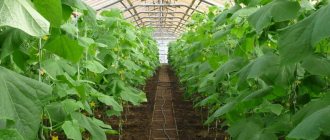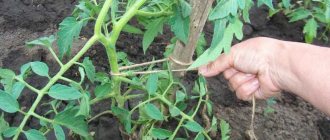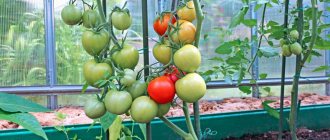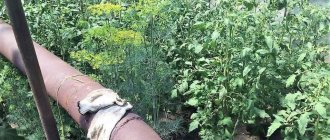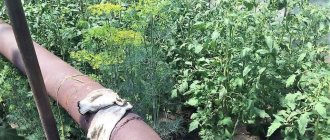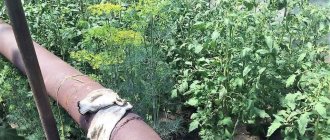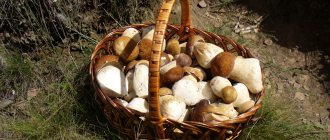Cucumbers growing in a greenhouse, photo
Very often, novice gardeners are somewhat confused by the following instructions placed on bags of cucumber seeds: “Plant plants at a distance of 30 cm from each other, followed by blinding at a height of 50 cm>...”. A completely reasonable question arises: what is blinding, when to carry it out, and in general, is it necessary to do it when growing in a greenhouse or greenhouse?
Let's figure out what blinding is, what types of cucumbers and when it needs to be done.
Structure and growth characteristics of cucumbers
Cucumbers are liana-like plants; they share numerous growth and development features with their overseas relatives:
- The root system of cucumbers is located 30 cm from the soil surface, but has a fairly wide branching. Good watering and fertilizing have a productive effect on its condition and lead to the formation of additional root shoots.
- The plant has a vine-like stem, which, thanks to its numerous tendrils, is able to cling to support and crawl upward.
- Cucumber plantings have both male and female flowers. They develop at the upper rudimentary leaves, forming small inflorescences. In classic varieties, mainly males are located on the central shoots; ladies prefer to grow on the side shoots.
- Not all cucumbers need pollination; there are special varieties for greenhouses and greenhouses, which are called parthenocarpic. They have much fewer male flowers than female ones.
- 15-21 days after the appearance of the ovaries, oval green fruits are formed. Classic varieties have a large number of seeds inside, which are formed as the fruit grows. The older the vegetable, the more there are.
In order for your plantings to produce a good harvest and not be subject to diseases and pests, you must provide them with proper care. In addition to your efforts, weather factors must also be taken into account. Delicious cucumbers grow at an air temperature of 25 degrees with good lighting. Night temperature should not be below 15 degrees.
Most regions of Russia are characterized by significant temperature changes, which can have a detrimental effect on plantings. Hypothermia of the roots often leads to the death of cucumbers. Therefore, it is most reliable to grow them in polycarbonate greenhouses. For some parts of our country, this is the only way to enjoy fresh vegetables from the garden.
Caring for cucumbers is quite simple and includes several basic processes:
- moistening the beds with water no colder than 22 degrees;
- periodic application of nitrogenous and phosphorus-potassium fertilizers to the soil;
- loosening to improve soil properties;
- pruning
Care after work
Even after the final formation of the bush, caring for cucumbers cannot be stopped. On the contrary, during the fruiting period the plant needs to be given as much attention as possible.
Proper care includes:
- Timely watering with warm water. Cucumbers are very afraid of any cold, so water from a hose will not work. Fill a barrel, basin or old bathtub and let the water warm up for a day.
- Regular weeding of the beds. There is not enough space in the greenhouse, so the problem of planting thickening is especially pressing.
- Removing damaged and diseased leaves. They do not allow cucumbers to fully develop.
- Timely harvesting. Don't let the cucumbers linger on the vines. Pick them as soon as they ripen.
- Additional plant nutrition. Experienced gardeners advise not only watering the cucumbers after planting, but also feeding them.
What is pinching and is it necessary?
Pinching involves removing the apical bud by any available method. Sometimes this procedure is also called pinching. It is carried out in order to avoid unfavorable factors:
- Strong growth of the bush, in which the main energy is spent not on the development of ovaries, but on the growth of shoots with leaves, which leads to the formation of barren flowers.
- Lack of light and moisture for overgrown plantings.
- Poor aeration between bushes.
- Spread of all kinds of pests and pathogens.
Pinching not only helps to curb the growth rate of plantings, but also helps to strengthen and enlarge the root system. This, in turn, allows you to take more moisture and nutrients from the soil.
How to pinch open ground cucumbers
The method of cultivating cucumbers in open ground affects the formation of fruits in the future. Those growing them on trellises should follow the methods described for greenhouse plants with minor adjustments. But cucumbers that grow freely in the soil require slightly different pinching. Moreover, the relevance of such an event depends on the density of planting of bushes.
Forming lashes on trellises
What varieties can you not pinch?
Modern hybrids and varietal cucumbers practically do not need pinching in the garden. These include:
- "Reliable";
- "Altai";
- "Aquarius";
- "Bush";
- "Competitor";
- "Lord F1";
- "SynthesisF1";
- "Rhythm F1" and others.
Such varieties branch well without outside help. In addition, there are modern hybrids, for example, “Farmer” or “Lord”, which create female flowers even on the main stem. Thus, you can choose any type of cucumbers, focusing on old and familiar varieties or purchasing more expensive modern hybrids.
Garter before pinching
Benefits of pinching greenhouse cucumbers
By pinching, you can control the process of new leaves appearing on plants. A large number of them absorb all resources, from light to organic substances obtained from the soil. This fact cannot but affect the quality of the crop, which is greatly reduced.
The shoots on cucumbers can only be pinched until flowering has begun and their length has not become more than 25 cm.
The plants that need pinching most are those that have too many male flowers. The main goal of the process is to maximize yield. Those gardeners who neglect the procedure have much less harvested vegetables than those who carry out proper and timely pinching.
Benefits of pinching:
- Activates the formation of female flowers.
- Increases planting productivity.
- Helps improve the taste of fruits.
The key to a successful pinching procedure is compliance with its basic rules. You can’t carry it out whenever and however you want. Here you need to take into account both greenhouse conditions and the arrangement of flowers. Otherwise, the bush may not form the required number of ovaries, and you will be left without a harvest.
Important tips for proper pinching
Every summer resident knows how to pinch cucumbers, but there are situations when, in the process of forming a bush, situations arise that require help. For those who have just begun to get acquainted with the garden, it is important to study all the information in detail in order to avoid unpleasant situations:
- In the process of gartering cucumbers, it is worth remembering the weak root system of the plant. The procedure should be performed carefully without harming the roots.
- During the formation of the bush, do not forget about loosening the soil around the plant.
- It is worth carefully ensuring that male inflorescences and unnecessary shoots are removed in a timely manner.
- When working with a bush, it is worth remembering not only the fragile root system, but also the fragility of the main stem. Perform all manipulations very carefully.
- Damaged tendrils or dry yellowed leaves should not be torn off, but carefully cut with scissors.
- When caring for cucumbers, you must use only clean tools for pruning in order to prevent the plant from becoming infected.
- It is not advisable to swap the tops of the bushes during harvest. This often causes yellowing and death of the plant.
- You should be careful with stumps after trimming the leaves. They cannot be left, otherwise the plant will be affected by powdery mildew, which will not allow the plant to form ovaries correctly.
The procedure for pinching cucumbers is quite complicated, but very effective. If done correctly, you can end up with a bountiful harvest of sweet cucumbers without bitterness.
When to pinch cucumbers in a greenhouse
Young and immature plants should not be pinched. After planting in the ground, they are given 2 weeks to adapt, after which the shoots can be directed to supports to which they will cling as they grow. At this stage, you need to remove those leaves and shoots that look sick and damaged, so that the infection does not spread to the main stem and destroy the plantings.
Pinching is also carried out when the plant is covered with barren flowers. Before doing this, you can try to dry the soil. The appearance of empty ovaries can be influenced by excessive waterlogging of the bed. If this does not help, then you need to cut off the male flowers.
Why do you need a pinch?
Some consider pinching cucumbers an unnecessary waste of time, since this type of vegetable crop can bring a decent harvest without it. However, experienced gardeners claim that in order to ensure the normal development of vegetables, as well as stimulate their growth, it is necessary to carry out pinching in combination with blinding.
Formation of cucumbers on an industrial scale
The structure of cucumber culture involves the formation of male flowers on the main stem (the so-called empty flowers). However, to improve the harvest, female ovaries are necessary. In the majority of varieties, similar sprouts grow on lateral stems. Therefore, it is extremely necessary to pinch cucumbers in a timely manner.
Also pinching:
- affects the ability to form more “female” ovaries;
- prevents the formation of bitterness in fruits;
- reduces shading of plantings;
- increases bush productivity;
- makes caring for plants easier.
Female ovary on a cucumber
Thanks to pinching, you can get high-quality fruits in large quantities. Breeders have developed varieties that produce female flowers on the main stem. In such plants, pinching is done to stimulate the formation of fruiting ovaries.
Still, you shouldn’t be too zealous and “bare” the plant, getting rid of all the leaves. Remember, in the future the leaves will give most of their nutrients to the fruits.
How to pinch cucumbers: selection of tools
Gardeners use various cutting objects for pinching. This could be scissors, a utility knife or pruning shears. Whatever you choose, it is important to remember that the edges should be very sharp and leave behind an even, neat cut rather than tearing the stem. In addition, all instruments must be well disinfected. To do this, you can take any alcohol-containing composition that is used to treat their surface, for example, an antibacterial spray or an alcohol wipe. Some gardeners use solutions of copper sulfate for this purpose, soaking tools in it. The procedure is carried out after each pruning so as not to transfer possible infections from one plant to another.
Young and very thin shoots can be pinched with your fingers. Hands must also be pre-treated. True, many gardeners consider this method to be the most dangerous from the point of view of seedling hygiene.
Benefits of cucumbers for humans
Among the vegetables in the garden beds, cucumbers are the first to ripen. Although the concept of ripening is quite relative for them. As soon as small greens appear, a person immediately picks them for consumption. And this is correct, because the fruits of the plant contain many useful substances that help:
- quench thirst;
- remove toxins from the body;
- strengthen the immune system;
- digest animal proteins.
But we don’t only think about health when fresh cucumber salads appear on the table, but also about how tasty this product is.
It’s impossible to imagine a summer menu without cucumbers. They are good in marinade and brine for the winter. Only a rich vegetable harvest will allow you to stock it for the winter. To do this, you need to properly pinch cucumbers and care for them in the greenhouse.
Rules and schemes for pinching cucumbers in a greenhouse
So, how to pinch cucumbers in a greenhouse?
If the process is very thin, then you can get by with pre-disinfected nail scissors. They must be well sharpened in order to cut and not wet the stem. Or just your own nails. Pinching - growth restrictions are applied to side shoots and the main stem.
Trimming procedure
Tendrils, male flowers, and leaves are also removed. They are cut off. Read about pruning cucumbers on our website.
Stepchildren also need to be removed. Cutting them to the very base is not recommended; it is enough to leave a stump of half a centimeter. By the way, cutting off stepsons (extra side shoots growing from the axils of leaves) is called stepsoning. You can read about this procedure on our website Mister Summer Resident.
Important! Determinate varieties of cucumbers, characterized by limited stem growth and a small number of side shoots, do not need to be pinched. The type of plant itself is already oriented towards high yield; pinching can lead to overload and breakage of the bush under the weight of the fruit. The most popular varieties: Hector, Malyshok, Buyan, Grasshopper, Chistye Prudy, Cappuccino. All these are hybrid varieties.
The procedure is carried out when the above-ground part of the plant is completely dry. The weather should be warm, without rain and high humidity.
Scheme for pinching classic insect-pollinated cucumbers
When purchasing cucumber seeds, carefully read the information on the package. As a rule, manufacturers indicate the optimal pinching pattern for forming a bush.
If there are no such recommendations, then follow the rule: the taller the plant, the greater the number of leaves, ovaries and shoots that can be left on it. Experienced gardeners offer a universal scheme for pinching a bush:
- When the stem height is about 50 cm, all side shoots that are located below the axil of the sixth leaf are removed. This is called the "blind zone".
- At a height of up to 1 m, only one ovary is left on the lateral shoots, the rest is removed by pinching it above the first leaf.
- At a height of up to 1 m to 1.5 m, you can leave 4 shoots, on which there are shoots with two leaves and two ovaries.
- If the cucumber variety requires a stem longer than 1.5 meters, then it must be thrown over a support and 4 side shoots must be pinched above the 4 ovaries.
- When the distance from the ground to the end of the stem approaches 60 cm, the top of the main lash needs to be pinched.
For such varieties, another formation is possible:
- The central stem is pinched after 5-6 leaves and tied.
- The side lashes are positioned at 60 degrees to the central one, removing all excess stepsons and mustaches.
- Shoots that grow to a horizontal trellis are wrapped around it and then pinched.
Scheme for pinching self-pollinating cucumbers
Self-pollinating cucumbers do not require the services of insects to pollinate flowers. Male flowers grow on the main stem, while female flowers are concentrated mainly on the side shoots. To make sure there are a lot of them, pinching is done.
For greenhouse plants, there is a certain scheme that must be followed to obtain an effective result from your work:
- The first three ovaries formed on the main stem are removed.
- To stimulate the growth of side shoots, remove the crown of the plant above the sixth full leaf.
- On the side shoots, pinching is carried out in such a way that 3 to 4 ovaries remain on each.
- After pinching, each new shoot is carefully tied to a support to avoid intertwining of the shoots.
Only late varieties of self-pollinating plants need pinching; all others, most often, grow well and bear fruit without this procedure.
Scheme for pinching parthenocarpic cucumbers
Parthenocarpic varieties of cucumbers do not require additional pollination by insects; predominantly female flowers are formed on their main stem.
Their side shoots grow quite quickly, so for comfortable growth and increased fruit formation they need to be pinched.
We offer you a step-by-step scheme for pinching these varieties in a greenhouse:
- The axils of the first four full leaves are freed from shoots, which are removed along with the flowers.
- In the axils of the fifth and sixth leaves, only 20 cm from the shoots are left.
- The 4 shoots that appear above need to be pinched 40 cm from their base, the next 4 are cut off at 50 cm.
- The main stem is pinched when 6 more leaves appear.
The tendrils and stepsons that appear in the leaf axils of hybrid varieties must be removed, and the remaining shoots must be separated from each other, each directed towards its own support, which will help to avoid their intertwining.
Some gardeners trim not only the shoots, but also the corners of overly large leaves, which create unnecessary shadows for the lower parts of the plant. This procedure will not cause any harm if the disinfection rules are followed, and will increase the lighting area.
Growing in closed ground step by step for beginners
Step 1. If the bush is not tied up, fix it and tie it to a trellis or any other support.
Cucumbers should be tied to a trellis
Step 2. As soon as the bush grows to 30-40 cm in height, we carry out the first stage of the procedure. We pluck out all the shoots from the leaf axils. Even those on which ovaries have already formed.
Please note this is very important. At a height of up to 40 cm, not a single stepson should remain on the main lash. Firstly, the root system will develop better this way. Secondly, all nutrients will be used for the further development of the plant.
IMPORTANT! After each pruning of shoots, it is necessary to water the bush abundantly with warm water and loosen the soil.
Step 3. The bush grows another 30-40 cm and begins to bloom. At this time, remove the lower leaves (those first 4 pieces). They are no longer needed. The bush is nourished by the upper leaves.
Step 4. So, the cucumber bush has grown to 70-80 cm. The lower part (at a height of 30-40 cm) is bare. Now on the upper part of the main stem it is necessary to leave only 1 flower emerging from the axil for each leaf. This is the future fruit. All other shoots are cut out.
Let's sum up the intermediate results. A cucumber bush looks like this. The lower half (about 40 cm) is bare, there are no shoots, leaves or shoots on it. There are 3-5 leaves on the upper half of the bush. Each leaf has 1 flower growing from its axil. There are no other escapes.
Step 5. We wait for the next growth of the main vine of the bush by 30-40 cm and the appearance of new stepsons on it.
Now there is no need to remove the shoots. On each shoot you need to leave 1-2 leaves with a flower. Exactly the same as was done in the previous step with the main stem.
Step 6. The bush has grown to approximately 1.2 - 1.5 m. Now you can give it free rein and not remove new shoots. By the way, the biggest harvest will be here. The side vines can be lowered down to the ground or allowed to trail along the trellis if your cucumber bushes are planted far apart.
IMPORTANT! If the plant begins to develop more slowly, or there are fewer fruits, then the cucumbers must be fed. A nutrient mixture based on peat fertilizer or ash is suitable.
Further care of cucumbers in the greenhouse
After pinching, the cut site must be treated, otherwise it may become a tasty prey for pathogenic microorganisms. To do this, plantings can be sprinkled with crushed wood ash. In order for the plants to better survive this stressful procedure, it is recommended to feed them with fertilizers after pinching.
You also need to water the cucumbers more carefully than usual. Water should not fall on the remaining stumps, so as not to provoke the development of putrefactive diseases.
What to consider for next year
To make it easier to pinch cucumbers, you must follow some rules when planting:
- distance between seedlings from 30 to 45 cm;
- no earlier than the 10th and no later than the 15th day from planting the seedlings - tying;
- removal of shoots and first ovaries from the bottom of the bush;
- maintaining healthy leaves.
It is also better to follow this sequence of actions:
- when the 6th leaf appears, cut off the top;
- we tie up the side vines;
- we cut off all the sprouts except the 3 strongest;
- remove all weak shoots and buds, leaving 4 on each stem.
Common mistakes novice gardeners make when pinching cucumbers
Proper care is the key to an excellent harvest at the end of the season. Violation of the pinching technique can lead not only to a decrease in the number of fruits, but also to the death of the plantings.
Some gardeners make common mistakes that should absolutely not be made:
- Pinching too late. If the shoots are strong enough, then after their removal the plant may get sick.
- Early growth intervention. After planting the cucumbers, you need to give them 2 weeks to adapt, during which no manipulations are carried out.
- Frequent removal of shoots. Pruning of shoots is carried out once every 3 weeks, otherwise it can cause stress in the plantings, which will lead to the development of diseases.
- Pinching by hand or with a blunt instrument. A bad cut can cause numerous infections. The cutting objects used must be sharp and well disinfected. Only very young and pliable shoots are cut off by hand.
There is also no need to overdo it with pinching, otherwise the plant will not be able to recover from stress and will die. In addition, not all varieties of cucumbers need processing, but you will still have to monitor the correct formation of the bush and correct it in a timely manner in order to get a rich harvest.
Possible mistakes
You need to carry out pinching with a garden tool
- Sloppy work. Shoots must be removed very carefully so as not to damage the leaf or flower. It is best to use a stationery knife. With its help you can make a neat cut.
- Carrying out the procedure too early or too late. Stepping should be carried out when the cucumber bush has at least 4 true leaves. Carrying out the work earlier will not bring any benefit. At the same time, if the side shoot has grown greatly, then it is too late to remove it.
- Failure to comply with pinching and pinching patterns. If you undertake the procedure, then follow the instructions and do not quit halfway through. Otherwise, you will not be able to fully appreciate the benefits of growing cucumbers in a greenhouse.
- No watering after the procedure. Stepping is still an injury to the bush. Therefore, after such stress, cucumbers need to replenish their supply of nutrients. Use only warm water. Ideally, this should be rain or river water. Never water cucumbers directly from a hose.
When not to pinch cucumbers
Thanks to the efforts of breeders, today there are a large variety of plant varieties, the care of which is minimized, and the yield remains very high. Many cucumbers no longer require pinching; this information is usually indicated on the manufacturer's packaging. Most often, this procedure is carried out with the aim of forming a bush, and not in order to obtain abundant lateral shoots. Although, if the planting has one central stem without additional shoots, pinching it is precisely the measure without which a rich harvest cannot be obtained. But if you are satisfied with the shape of your plant, it has enough side shoots, they do not interfere with each other, then there is no need to interfere with its growth.
Rules for the procedure
Proper pinching of cucumbers is an important procedure, after which the plant begins to receive more sunlight and important elements for the formation of good fruits. In order to form a bush, it is necessary to pinch individual stems of the plant. Thus, a properly designed bush will produce good fruit.
It is worth taking into account that cucumbers have a poor root, which cannot fully provide the ovary and fruits with useful elements. For this reason, the plant may have yellow leaves that soon wilt.
If the procedure for forming a bush is carried out according to all the rules, then these problems can be avoided. Such bushes will yield much more harvest than those that grow unformed.
It is also recommended that the summer resident ensure that excess stems on the vegetable are removed in a timely manner, otherwise this may affect the fruiting of the crop.
Mr. Summer Resident recommends: which varieties of cucumbers do not need pinching
If you are not ready to spend your time and effort on additional work with plantings, then choose varieties that do not require pinching.
Zozulya
Today you can buy cucumbers that develop with one full-fledged stem and have practically no lateral shoots, but their fruits grow in a large bunch and have a delicate taste without any bitterness. If you water and feed cucumbers correctly, you can harvest up to 500 cucumbers from one such bush.
Hybrid varieties are marked F1 on the packaging. Among the best varieties that are suitable for growing in a greenhouse are the following varieties:
- Alphabet is early ripening, has up to 5 ovaries per node, the main crop ripens on the main stem.
- Bouquet - has up to 6 ovaries in a node, is resistant to common diseases, has practically no side shoots.
- Regina Plus - the fruits are characterized by the absence of bitterness, the plant is not prone to forming lateral shoots, and is immune to many diseases.
- Matilda - bears fruit early, has up to 7 cucumbers in the ovary.
- Zozulya is distinguished by its large cucumber size, which grows up to 25 cm. The harvest can be harvested within 40 days after germination.
Hybrids for greenhouses are good because they do not need to form a blind zone at the base. The varieties Severyanin, Vyuga, Metelitsa and Valdai are distinguished by their slight branching. For closed planting, you need to choose self-pollinating varieties of cucumbers.
Forming a bush into several stems
This method of formation involves bushes with several main side stems.
How to make the formation:
- the main stem is stretched and fixed with a strong rope;
- until the first ovaries appear, the side shoots are not touched;
- after the first ovaries appear, the lateral shoots are attracted to the main stem;
- tendrils that grow from shoots tie the plant to the main stem;
- As the next shoots grow, they are tied to the main stem.
How to pinch
The pinching procedure is very simple. Experienced gardeners recommend trimming shoots with sharp scissors or a knife. If you do this with your hands, you can damage the stems, resulting in a risk of infection of the plant.
You need to pinch the lashes with sharp scissors
Before processing each bush, I wet the scissors in a solution of potassium permanganate. This helps prevent the spread of infections. I cut no more than a sixth of the green mass at a time. If you delay pinching and then do all the pruning at once, the cucumbers may die.
